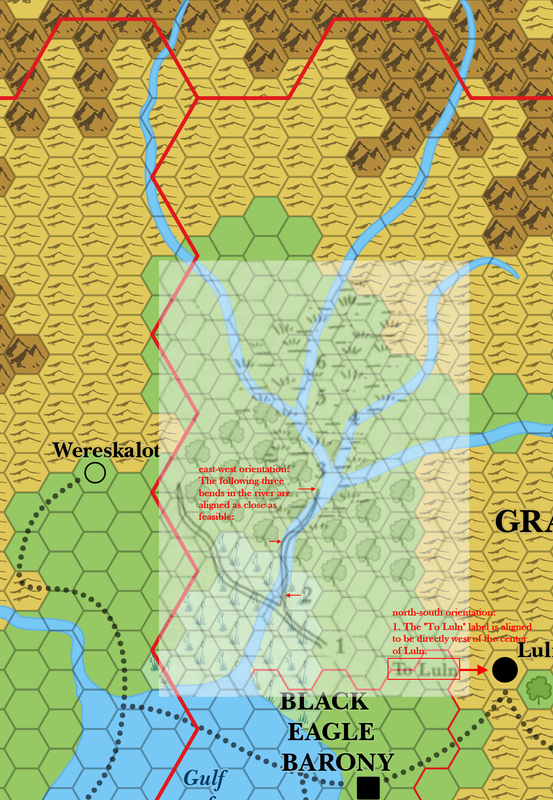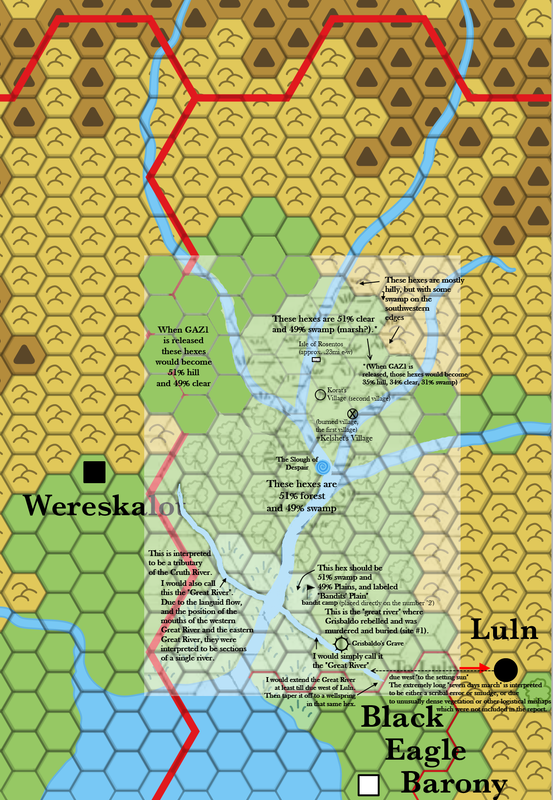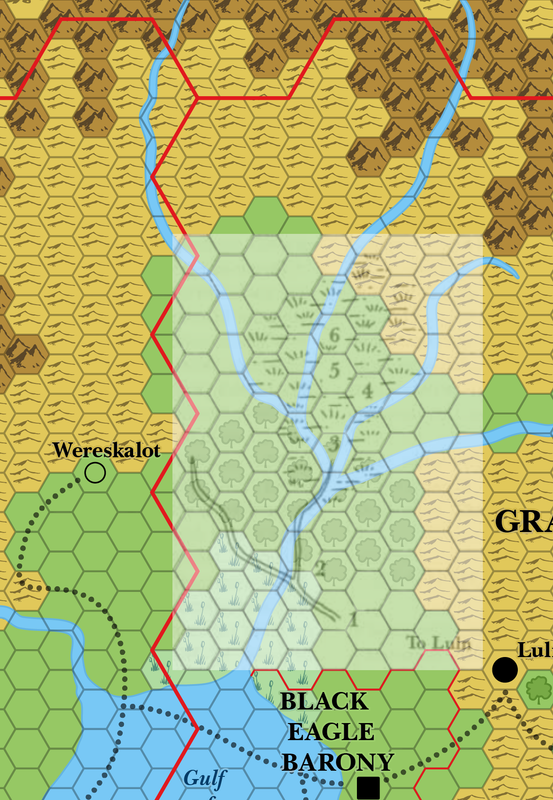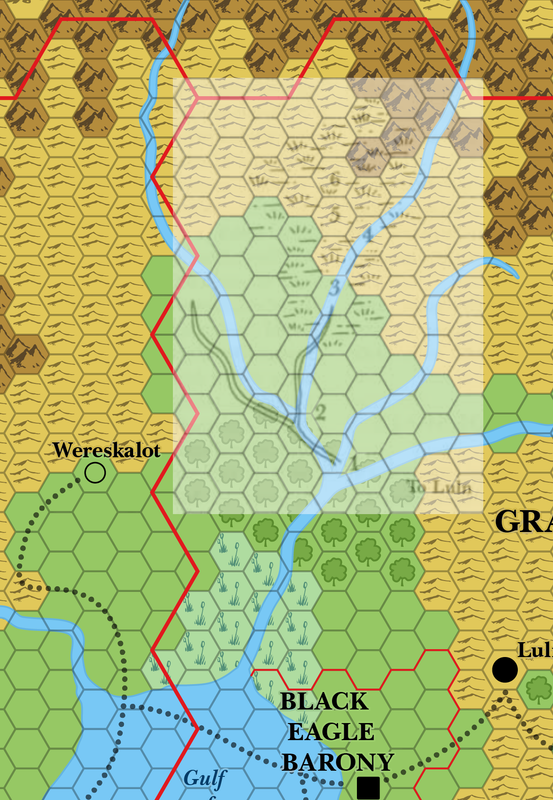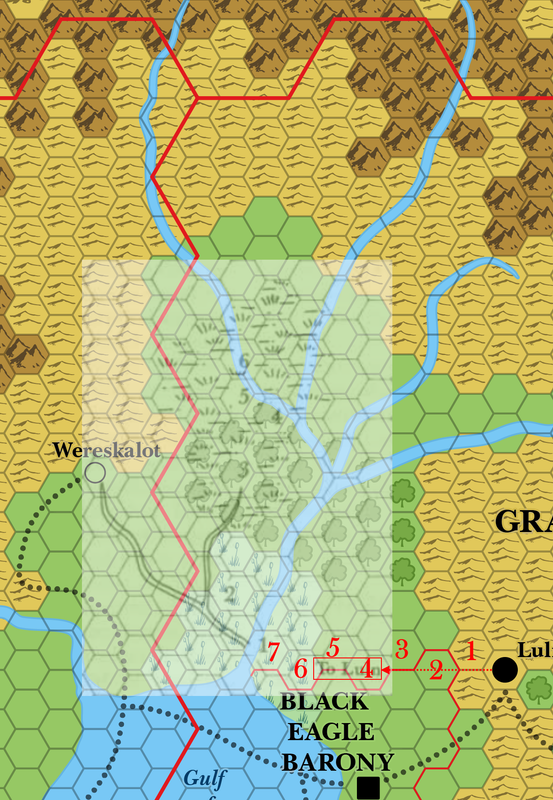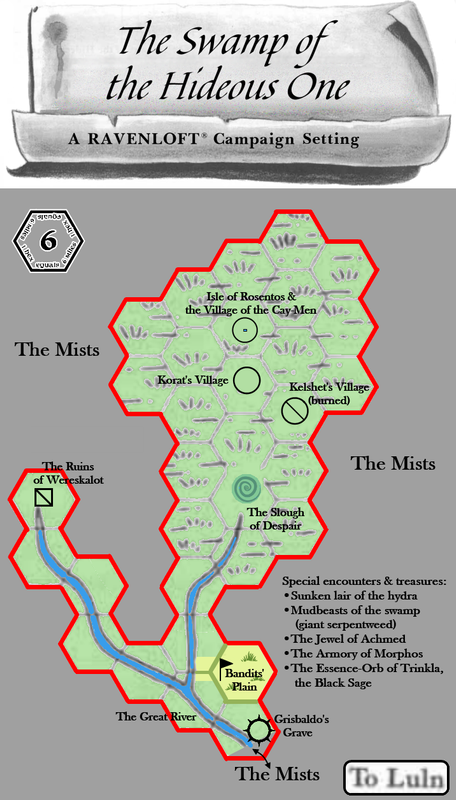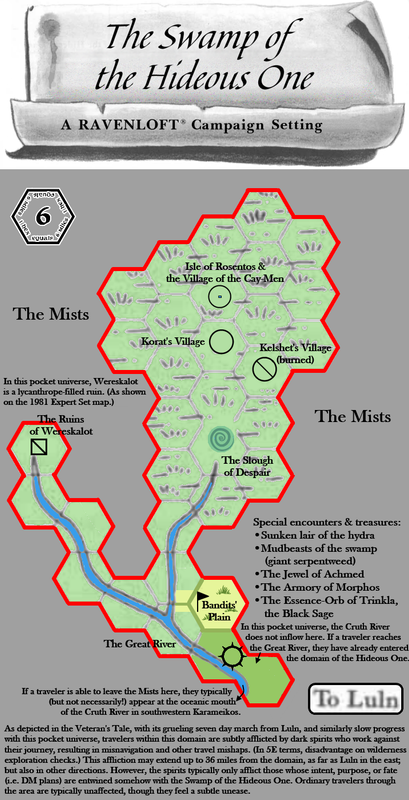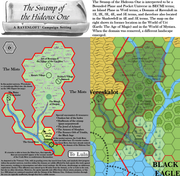
Placing AC2: Treasure of the Hideous One (1984)
by Sionainn T. Mac InnéirgheThis is one of the awkward maps. Like Gulluvia (orange B3) and The Rock (B8).
But AC2 map is explicitly an Official map of Mystara. And large-scale maps ought to trump small-scale maps. The Officialness is stated on page 1: "This adventure is set in the same campaign world as all other D&D@ Basic and Expert adventures (for a map of the land, see p. 32 of the Expert rule book). If the players follow the clues, their characters probably set out on the adventure from the village of Luln."
I see three "sticking-near-to-official" options:
Option A) Merge the maps; for example, like that.
Option B) Totally ignore the AC2 "Suggested Wilderness" map (p.3) since it's only "suggested." And because the caption rather bluntly states: "This map does not exactly match any map in the Expert rules. Because of this, you may place
this map where you wish." (like, wth!)
Ignoring the map would mean, just taking the encounter sites from the map and text, and placing them in an approximately interpolated (but shrunken) distance from each other, on the proper/actual map of the Blight Swamp.
Option C) Consider the AC2 map to be an accurate map of the terrain 100 years ago, but the area was taken by the Darklords of Ravenloft, and new/different terrain was emplaced on Mystara to fill the hole left in the world.
I would suggest these names for the two villages:
- Kelshet's Village (the "first village", the "burned village"). We don't know if, at the time of the conflict, Kelshet was the chief of the first village, or if he was the chief of the second village. But either way, the first village was destroyed. So either Kelshet was the leader who lost, or he was the leader (of the second village) who conquered the village. So either way, it's Kelshet's village!
- Korat's Village (the "second village"). The name of the current chief.
Also, there are settlements on the Isle of Rosentos, but I failed to mark them on the map:
"the slave farm"
"the village of the cay-men"
Also of note, my research suggests that Korat's Village are M-Garifuna people. And the Cay-men are M-Galibi. Here's where I sussed out the ethno-cultural analogues.
Yes, M-Caribbean Indians, right there in western Karameikos. In Karameikos, we got Slavic/Romanian/Hungarians, Byzanto-Latin-Germans, quasi-Egyptian jackalfolk, bald sonic Traldar, lupins and rakastas of various breeds, and Carib humans and caimanfolk!
I guess another semi-reasonable option would be to sort of assume that the cartographer of AC2 was looking at the contents (hex by hex) from the 6-mile Karameikos hex grid when he free-handed the shape of the river. I don't believe he necessarily was...but maybe he was...and so it's another reasonable approach. The hex grids themselves would best align in this way:
But, for the sake of research, here's an alignment of the river forks, and with the hex grids aligned.
And, while we're examining all plausible placements, it seems there is some chance that the designer's march of "7 days" was based upon a simple counting of the 7 hexes between Luln and the river. Which of course would be a "wrong" way of calculating wilderness movement, but the fact that they're both 7 is suggestive.
This map is aligned in that way, with also the "To Luln" label aligned north-south so that it's centered on Luln:
So there are four reasonable placements, each of which is based on palpable factors.
However...if someone doesn't want to disturb the familiar, iconic map of western Karameikos, but also doesn't want to shuffle the sites from the AC2 map to make them fit in the Blight Swamp (Option B), I would suggest Option C...removing the Isle of Rosentos and its surrounding wilderness, as a Domain of Dread.
I updated the Option C map:
-Clarified the relationship with the mouth of the Cruth River.
-Added Clear terrain for one hex west of Grisbaldo's Grave, since the text said that the horses could travel along the bank at first, until it turned to swamp.
-Added explanation of the Ruins of Wereskalot
-Added explanation of the dark spirits who afflict navigation and travel
And here's another update, this time showing where this Domain of Dread was removed from the World of Urt and Mystara, after the events of AC 900 (the Veterans Tale):
This is actually where I wanted to land in this thread. I laid out four reasonable placements. But I still personally feel that the two maps (AC2 map and the familiar map of western Karameikos) are best preserved by making the area a Domain of Dread, taken from Mystara, and longer located on the Prime Plane. That's actually my most preferred solution for The Rock and City of Tuma, and for the Barony of Gulluvia and its Surrounding Lands.
P.S. I revised the map to add Heavy Forest for the two hexes which lead into the Swamp. I had originally thought that clear terrain was default for non-wetlands in the area (based on the clear terrain of the Black Eagle Barony), but looking at later maps of Karameikos, the natural vegetation for that latitute band in Karameikos appears to be heavy deciduous forest. This would be from 100 years before 1000 AC, when the terrain west of Luln hadn't yet been cleared by farming. Having heavy forest hexes instead of clear would help explain the extremely long travel times which the expedition experienced.
Also, an explanation as to why I don't connect the inflow of the Cruth River (in the Prime Plane) with the mouth of the Great River (in the Pocket Universe): Because the text of AC2 says that they when reached the great river, and slew and buried Grisbaldos, the horses still traveled up the river (i.e. northwest on the AC2 map) for a day (which I "artistically" convert to 1 more hex beyond Grisbaldos' Grave, based on my similar "conversion" of "7 days west" to "7 hexes west" of Luln). They didn't build rafts and take to the water till then. Because they were still traveling with horses, on dry land. But if the Cruth River flowed through there (north-south), they would have had to have immediately made rafts just to cross the river. So the two rivers are not connected in a physical sense.
